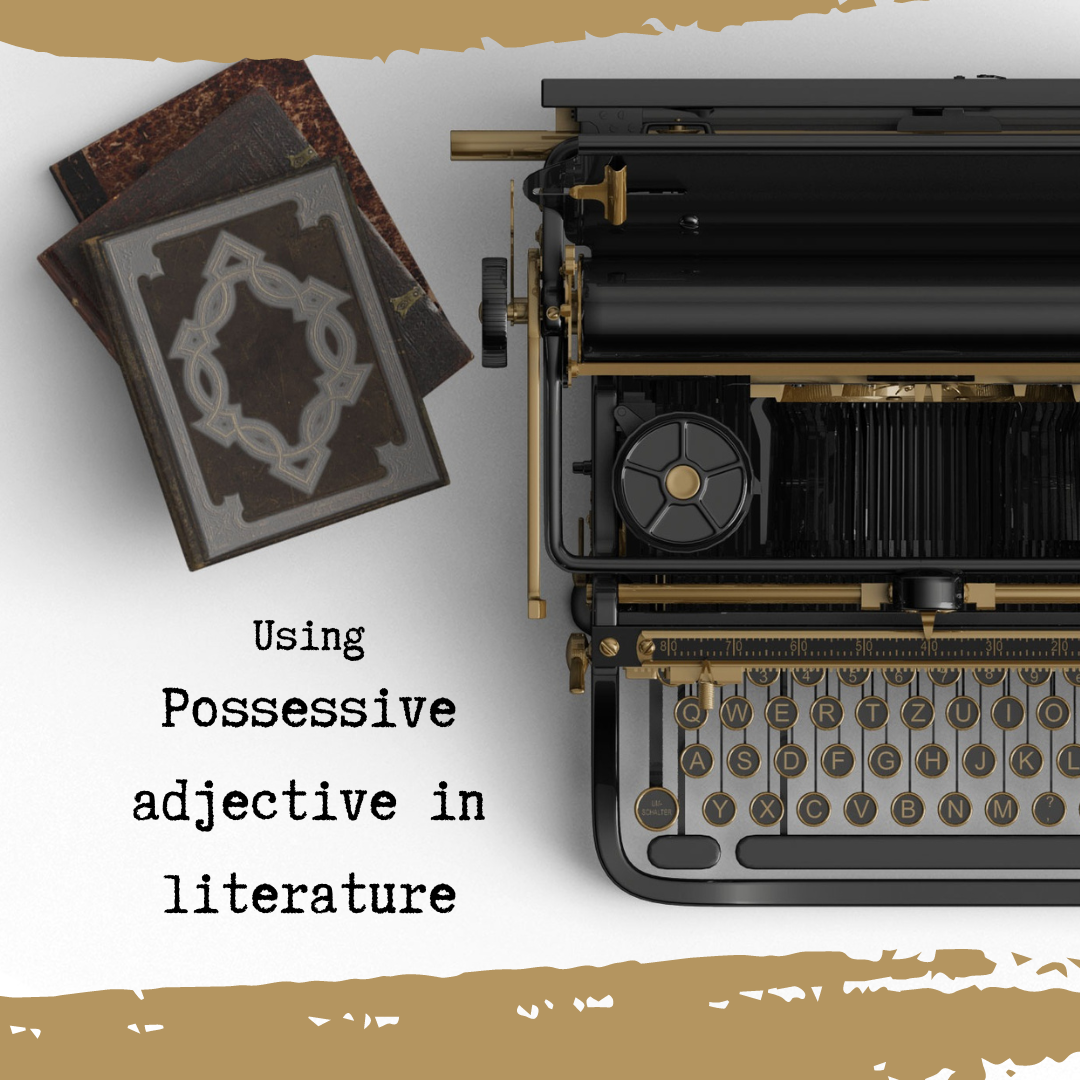Possessive adjectives in literature are a type of words used to indicate ownership or possession in a sentence. These adjectives modify a noun to show that the noun belongs to someone or something. In English, common possessive adjectives include “my,” “your,” “his,” “her,” “its,” “our,” and “their.”
In literature, possessive adjectives are used to add detail and specificity to the characters and objects in a story. They help convey relationships, ownership, and connections between characters and their possessions. By using possessive adjectives, writers can create a sense of intimacy, emphasize personal connections, and provide insights into the characters’ personalities and emotions.
For example, in the sentence “Her mysterious book captured my attention,” the possessive adjective “her” indicates that the book belongs to someone, adding a personal touch to the description and suggesting a connection between the speaker and the character possessing the book. Possessive adjectives play a crucial role in enhancing the richness and depth of language in literature.
Let’s see how to explore possessive adjectives are used in literature to develop characters and convey emotions:
Possessive adjectives in literature play a significant role in developing characters and conveying emotions by adding depth, nuance, and personal connections to the narrative. Here’s how they are used:
1. Expressing Relationships:
Example: “His beloved dog wagged its tail eagerly.” In this sentence, the possessive adjective “his” not only indicates ownership but also suggests a strong emotional bond between the character and the dog.
2. Conveying Ownership and Identity:
Example: “My grandmother’s antique locket held a secret.” The possessive adjective “my” adds a personal touch, and the possession of the locket implies a connection to the character’s family history, contributing to the character’s identity.
3. Creating Intimacy and Connection:
Example: “Our shared memories lingered in the old house.” The possessive adjective “our” suggests a shared history and emotional connection between characters, creating a sense of intimacy and camaraderie.
4. Eliciting Empathy:
Example: “Her lost son’s photograph brought tears to her eyes.” The possessive adjective “her” in this context conveys a deep emotional attachment, and the loss of the son is emphasized through possession, evoking empathy from the reader.
5. Revealing Character Traits:
Example: “His worn-out guitar revealed years of passionate playing.” Here, the possessive adjective “his” not only indicates ownership but also provides insight into the character’s passion and dedication.
6. Building Tension or Conflict:
Example: “Their opposing views led to heated arguments.” The possessive adjective “their” highlights the conflicting ownership of opinions, setting the stage for tension and potential conflict between characters.
7. Highlighting Emotional States:
Example: “Your unexpected arrival brought joy to my heart.” The possessive adjectives “your” and “my” together convey a personal and emotional response, illustrating the impact of the arrival on the character’s emotional state.
In summary, possessive adjectives in literature go beyond indicating ownership; they serve as powerful tools for authors to infuse emotion, depth, and complexity into characters and their relationships. By choosing specific possessive adjectives, writers can guide readers to connect with characters on a more personal and emotional level, ultimately enhancing the overall impact of the narrative.
Let’s see few examples from well-known literary works:
Expressing Relationships:
- Example: In Emily Brontë’s “Wuthering Heights,” Heathcliff’s obsessive love for Catherine is evident through possessive language. “His heart and soul were hers—belonging wholly to the wild spirit that was Catherine Earnshaw.”
- Conveying Ownership and Identity:
- Example: In F. Scott Fitzgerald’s “The Great Gatsby,” Gatsby’s possession of a green light across the bay becomes a symbol of his unrequited love and his pursuit of the American Dream. “Gatsby believed in the green light, the orgastic future that year by year recedes before us.”
- Creating Intimacy and Connection:
- Example: In J.K. Rowling’s “Harry Potter” series, the possessive adjectives used by the characters strengthen their bonds. “Our spells intertwined as Harry and Hermione fought side by side, their shared experiences creating an unbreakable connection.”
- Eliciting Empathy:
- Example: In Khaled Hosseini’s “The Kite Runner,” Amir’s possessive guilt over his betrayal of Hassan is palpable. “His voice haunted me as I thought about my lost friend, the guilt of abandoning him always present in the back of my mind.”
- Revealing Character Traits:
- Example: In Jane Austen’s “Pride and Prejudice,” Mr. Darcy’s possession of pride and Elizabeth Bennet’s possession of prejudice create tension. “His wealth and social standing were his pride, while Elizabeth’s quick judgments were her shield against perceived slights.”
- Building Tension or Conflict:
- Example: In William Shakespeare’s “Othello,” the possessive adjectives contribute to the jealousy that drives the tragedy. “Othello’s possessiveness over Desdemona fueled Iago’s manipulation, leading to the tragic unraveling of their love.”
- Highlighting Emotional States:
- Example: In Gabriel Garcia Marquez’s “One Hundred Years of Solitude,” the Buendía family’s shared history is conveyed through possessive language.
Let’s see Cultural or Contextual Considerations in possessive adjectives:
Cultural or contextual considerations in possessive adjectives refer to the influence of cultural and societal norms on the usage and interpretation of these adjectives in language. Different cultures may have distinct ways of expressing ownership, relationships, and emotions, affecting how possessive adjectives are employed and understood. Here are a few key points:
1. Cultural Norms and Expressions:
Cultural differences can shape the intensity or subtlety with which possessive adjectives are used. For example, some cultures may have more explicit expressions of familial or personal ownership, while others might rely on implicit cues.
2. Hierarchy and Social Relationships:
Cultural hierarchies and social structures can impact possessive language. In some societies, there might be specific possessive terms or expressions used within certain relationships, reflecting the cultural emphasis on hierarchy or equality.
3. Gender Roles and Language:
Cultural norms regarding gender roles may influence the use of possessive adjectives. In certain cultures, there might be specific linguistic nuances when expressing possession based on gender, reflecting societal expectations and attitudes.
4. Emotional Expressiveness:
Cultural attitudes towards emotional expressiveness can shape the use of possessive adjectives to convey feelings. Some cultures may embrace a more reserved approach, while others may use possessive language more openly to express emotions.
5. Cultural Sensitivity:
Writers and speakers need to be aware of cultural sensitivities when using possessive adjectives, especially in a global context. What might be considered endearing in one culture could be perceived differently in another.
6. Idiomatic Expressions:
Possessive adjectives are often embedded in idiomatic expressions that carry cultural meaning. Understanding these expressions requires familiarity with the cultural context in which they originate.
7. Historical and Contextual Nuances:
Historical events and contextual factors can influence the use of possessive adjectives. For instance, in literature set in a specific historical period, possessive language may reflect societal norms of that time.
Considering cultural and contextual aspects is crucial for effective communication and for creating authentic, culturally sensitive portrayals in literature. Writers must be mindful of how possessive adjectives align with or deviate from cultural expectations, enriching the narrative by incorporating these nuanced linguistic elements.
Let’s see interactive Elements in Possessive adjectives :
Interactive elements in possessive adjectives, when referring to language and communication, typically involve how speakers or writers engage with their audience or readers using these linguistic constructs. Here are some considerations:
1. Engagement with Readers:
Writers can use possessive adjectives to engage readers emotionally. By creating a sense of ownership or attachment through possessive language, authors can make the audience feel more connected to the characters and the narrative.
2. Character Development:
Interactive storytelling often involves the audience in the character’s journey. Through possessive adjectives, writers can provide insights into characters’ personalities, relationships, and emotional states, allowing readers to form a deeper connection with the narrative.
3. Cultural and Contextual Understanding:
Authors can use possessive adjectives to convey cultural and contextual nuances. Interactive elements might include the exploration of how possessive language varies across cultures, allowing readers to gain a richer understanding of the characters’ backgrounds.
4. Dialogue Dynamics:
In dialogue, possessive adjectives play a crucial role in shaping relationships between characters. Interactive elements can involve using possessive language strategically to indicate power dynamics, intimacy, or conflict within conversations, enriching the interactive experience for the reader.
5. Reader Inference and Imagination:
Interactive storytelling often invites readers to actively participate in the narrative by leaving certain details open to interpretation. Possessive adjectives can be used to spark the reader’s imagination, allowing them to fill in the emotional nuances and relationships between characters.
6. Reflecting Personal Experiences:
Writers might use possessive adjectives to tap into universal themes or personal experiences. This can create a sense of relatability, encouraging readers to reflect on their own relationships and emotions as they engage with the narrative.
7. Creating Suspense or Surprise:
The strategic use of possessive adjectives can contribute to building suspense or surprising plot twists. By guiding the reader’s attention through possessive language, writers can manipulate expectations and enhance the interactive nature of the storytelling experience.
8. Interactive Reading Communities:
In the digital age, interactive elements extend to online communities of readers. Authors can use possessive adjectives to encourage discussions and interpretations among readers, fostering a sense of community around the narrative.
Ultimately, interactive elements in possessive adjectives involve using language intentionally to involve the audience actively in the storytelling process, fostering a more engaging and immersive experience for readers.
Let’s see the conclusion and recap possessive adjectives: In conclusion, possessive adjectives in literature serve as powerful tools for shaping characters, conveying emotions, and engaging readers in an interactive storytelling experience. These linguistic elements go beyond mere ownership, offering writers a means to establish relationships, reveal character traits, and create cultural and contextual depth within a narrative.
Through the strategic use of possessive adjectives, authors can foster a deeper connection between readers and characters, inviting them to emotionally invest in the story. The interactive elements involve not only the portrayal of relationships but also the careful consideration of cultural nuances, dialogue dynamics, and the intentional creation of suspense or surprise.
By incorporating possessive adjectives, writers can tap into readers’ imagination, encourage personal reflections, and even contribute to the development of online reading communities. This linguistic approach adds layers of meaning to the narrative, making it more relatable, immersive, and resonant.
In recap, possessive adjectives serve as nuanced building blocks in literature, allowing authors to intricately weave connections between characters and readers, evoke emotions, and create a more interactive and engaging storytelling experience.
If you want to speak English naturally and fluently just like your mother tongue, click here.

